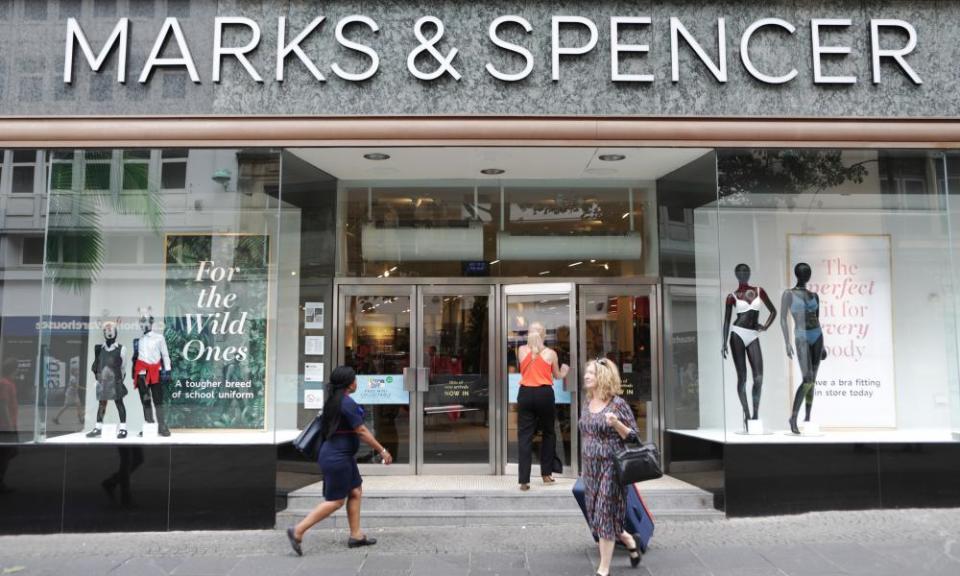We can’t rely on shops to revive our town centres. They need a new magnet
Another winter passes, and the plague continues its rampage through the high streets of Britain. Shutters are going up and stores are closing. The disease fells everything from the corner post office and pub to mighty names like M&S, Debenhams and House of Fraser. Like the climate crisis and the erosion of the countryside, the traumas of urban geography pass unnoticed because their impact is local. But the world is composed of locals.
Related: We can revive Britain’s high streets. But developers stand in the way | Tony Naylor
High streets are seen by planners as places where people shop. They are not. In their winding, funky idiosyncrasy, they are places of character, where people congregate, communicate and feel at home in company. They are human constructs. Their shops can be replaced by out-of-town hypermarkets, and now by online warehouses. But their society is irreplaceable. The two high streets I know best, in central London and rural Wales, are linchpins of their communities. But they are plagued with hoardings. They are collapsing.
The figures are grim. November capped another dire year, with retail footfall down 4.3%, accelerating last year’s 3.8% drop. Even sales of groceries were down at Sainsbury’s, Asda and Tesco. Fashion outlets have led the plunge this year, followed by restaurants, pubs, banks and electrical stores. Four hundred village shops are closing annually. Some of the UK’s biggest retail landowners will this year stand to have billions wiped off their value. This is the tipping point into catastrophe.

The reason is simple: “clicks for bricks”. In 2017, online shopping was forecast to rise from 17% of consumer spending to 40% by 2030. Clothing has reached those heights already. Online retailers deliver goods to the door. Free returns enable people to order clothes, wear them once and send them back – and still the retailer makes a profit.
The telltale is America. There, according to Deloitte, this Christmas clicks will overtake bricks, with an average online household spend of $879 (£670) against $541 in stores. Shopping malls are falling empty. Sears, RadioShack and Toys R Us stores have dramatically dwindled or gone altogether. Since the start of 2017, 150,000 jobs have been lost in the American retail sector. An era is passing.
Is there any light? Not much. In Britain, governments have done all they can to kill off high streets. Ministers have capitulated to the “Tesco lobby”, allowing out-of-town to replace high street wherever it wanted. High streets from Chichester to Penrith have had the commercial blood sucked from them. Acres of countryside have vanished to car-borne shoppers at hypermarkets, which will soon lie as deserted as petrol stations. This was mindless planning.
Meanwhile the Treasury has savaged town centre shops with murderous business rates, while letting off out-of-town retail virtually free. The wheel has now travelled full circle, as out-of-town now howls about online retail getting away with fiscal murder. John Lewis’s business rates in its flagship London store rose from £6.6m to £10.5m in just three years. Selfridges pays £17m in similar rates, more than Amazon’s total corporation tax bill. All governments promise to reform these rates, but never do.
In the US, the fightback is desperate. High streets may be dying, but malls are shifting to become “social and sensory experiences”. One of the few new ones, American Dream in New Jersey, is just 45% retail, built around an amusement park, Legoland and a skating rink. At the other end of the scale, ubiquitous French town halls are being converted into one-stop local shops and service centres.
British high streets are stumbling fitfully into the experience economy. Surviving shops focus on beauty, fitness, coffee, charity and loans. Intriguingly, too, the number of bookshops is actually rising. In some of its locations, Ikea offers not goods but “planning studios” for online shoppers.
A more intelligent government initiative has been the modest £40m boost to Historic England’s “heritage action zones”, driven by evidence that smartening up old high streets makes them attractive destinations to casual shoppers or just visitors. Enlivening Derby, Altrincham and Woking has been startlingly successful. Likewise, new village community stores are opening by the week. The one at Ewelme in the Chilterns recently celebrated its 10th birthday.
If there is social wrong that cries out for a solution it is personal isolation. The bonds that once held people of all ages in the embrace of neighbourhood and community are snapping. This stretches from the Facebook agonies of the young to the greatest curse of old age, not ill-health, but loneliness. The humdrum institutions of the high street – the pub, the library, the police station – were all salves to such ailments. But the magnet was the need to shop.
That magnet now must become the craving to congregate, the search for company and enjoyment. The marketplace is clearly shifting to services and experiences, but one solution would be a version of France’s town hall enterprise. It would be the commandeering of the one building that is immovable and familiar to all, the local church. In the middle ages, the church was a true one-stop shop for local activity and welfare. For young and old, busy and idle, profit and loss, art and music, it should be that again.
Related: Retailers call for action as high street store closures soar
British government policy towards high streets has been like the French revolution towards all manifestations of localism. It was to crush identity under the hammer of statist uniformity. Whitehall policy at present is to replace the old vigour of the high street not with new, but with acres of anonymous housing estates, serviced by the drones of Ocado and Amazon. It is madness.
• Simon Jenkins is a Guardian columnist

 Yahoo News
Yahoo News 